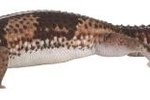Skinks and salamanders are commonly confused, but they are very different types of animals requiring completely different husbandry. Skinks are reptiles, like snakes, turtles and crocodiles; salamanders are amphibians, like frogs are. Skinks exhibit much greater species diversity than salamanders do: The subclass Caudata – which contains all of the world’s living salamanders – contains approximately 420 species, while the skink family, Scincidae, contains over 1,000 described species.
Physical Similarities and Differences
Although exceptions exist – a few salamanders have lost their rear legs over evolutionary time – skinks and salamanders have broadly similar body plans, which feature four legs, elongate bodies and long tails. However, as reptiles, skinks have dry, scaly skin, and salamanders have moist, permeable skin, as most other amphibians do. This means that salamanders dehydrate much more rapidly than skinks do when exposed to dry conditions, which produces differences in habitat preference and behavior.
Behavioral Differences
Because skinks and salamanders have lots of predators, they both tend to be secretive animals who spend the bulk of their lives hiding under rocks, logs or other forms of shelter. However, because amphibians dry out easily, they tend to restrict their above-ground movements to times of high humidity and low temperature. Some salamanders take this approach to the extreme, becoming completely aquatic animals. Skinks can swim, and many species live in close proximity to water, where their insect prey abounds, but only a handful of skink species could be considered aquatic. Conversely, many skink species have colonized deserts and other arid habitats, while the most common terrestrial salamander habitats are forests.
Captive Care
Most commonly kept salamanders are small species who will thrive in a 10- to 20-gallon-aquarium. By contrast, a few skink species, such as prehensile-tailed skinks (Corucia zebrata) and blue-tongued skinks (Tiliqua ssp.), grow much too large for cages of this size. Provide such species with at least 4 to 8 square feet of floor space. Blue-tongued skinks require rather little cage height, as they are terrestrial critters, while prehensile-tailed skinks are arboreal animals requiring cages with at least 3 or 4 feet of height.
Most salamanders thrive at room temperature, and they probably do not require UVB lighting. Skinks, on the other hand, require a heat lamp and basking area, over which you must place a full-spectrum light that produces light in the UVB portion of the spectrum. Terrestrial salamanders and forest-dwelling skinks require wood mulch or soil substrates, while skinks from arid habitats adapt better to sand- or gravel-based substrates.
Several salamander species exhibit unusual life cycles, which has implications for the keeper. Some mature while retaining their juvenile characteristics – a phenomenon called neoteny. Others begin life in the water, move to dry land for a few years and then return to the water for the duration of their lives. You will have to use heating and filtering equipment to keep the water in an aquatic salamanders' tanks optimal.
Feeding Your Pet
Although there is some variation among salamanders, most species will accept invertebrate prey – crickets, earthworms and roaches – as readily as skinks will. While amphibians don't drink much water, terrestrial salamanders require a water dish in which they can absorb water through their skin and cloacae. Skinks require water for drinking, but they will rarely soak in their dish.
Warnings
Some skinks can bite hard, and salamanders produce toxic secretions, so exercise discretion and care when handling them.
Always wash your hands after handling any reptile or amphibian.
Common Pet Salamanders
- Mandarin newt (Tylototriton shanjing)
- Japanese fire-bellied newt (Cynops pyrrhogaster)
- Three-toed amphiuma (Amphiuma tridactylum)
- Tiger salamander (Ambystoma tigrinum)
- Axolotl (Ambystoma mexicanum)
- Eastern newt (Notopthalmus viridescens)
Common Pet Skinks
- Five-lined skink (Plestiodon fasciatus)
- Broad-headed skink (Plestiodon laticeps)
- Blue-tongued skink (Tiliqua ssp.)
- Prehensile-tailed skink (Corucia zebrata)
- Ocellated skink (Chalcides ocellatus)
- Schneider’s skink (Novoeumeces schneideri)




